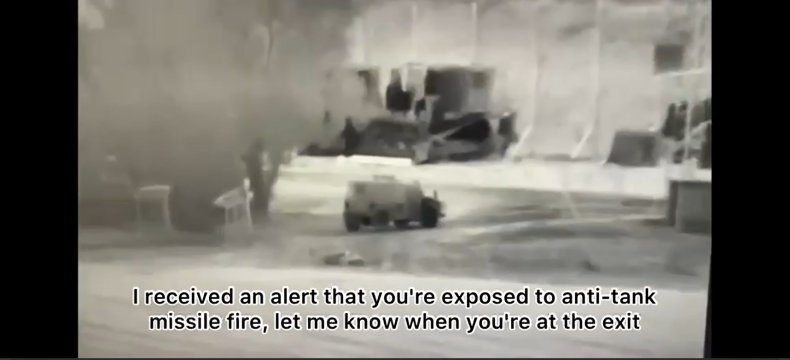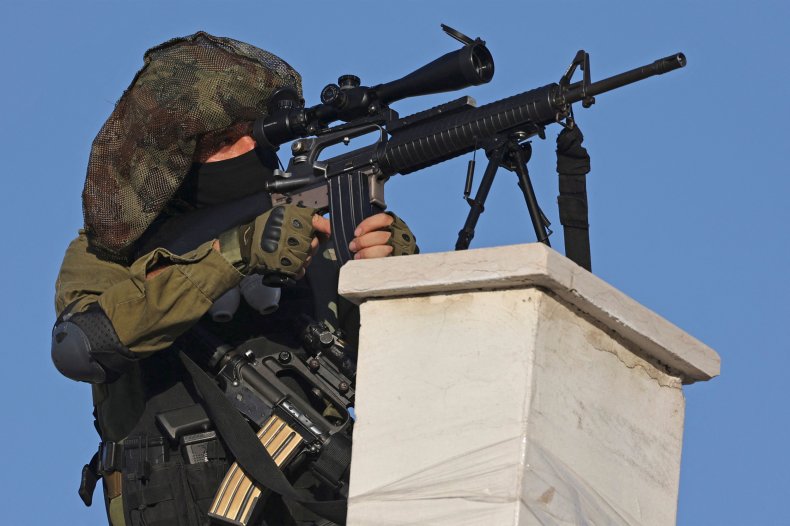TOM O'CONNOR
The Israel Defense Forces (IDF) have established a new high-tech system that provides real-time tracking of troop locations and where they may be exposed to enemy fire, offering the country a significant digital edge on the battlefield.
In the first explanation of what's known as the Identify & Alert ("I&A") System to the international media, two senior Israeli officers discussed with Newsweek how the platform works and what it means for the future of warfare.
Contending with foes tied to longstanding conflicts on nearly every border, Israeli troops have frequently faced sudden hostilities from a range of actors, making it difficult to anticipate attacks.
Lieutenant Colonel Idan Hariri, outgoing commanding officer of the IDF J6 and Cyber Defense Directorate's Gaza Battalion, told Newsweek that, "we took these events and thought about their common denominator and how we can improve toward the next operation by developing a new system, such as alerting soldiers that are at risk from anti-tank missile fire and sniper fire."
"We understood that we can identify all the soldiers with 'Torch-X' (a command and control system belonging to Elbit Systems Ltd.)," he added.
Elbit Systems Ltd. is an Israel-based international defense electronics company that works with a range of air, land and sea systems with both military and commercial applications, including some of the IDF's cutting-edge platforms.
"We entered a process of characterization, investigation, and development, together with the 'Matzpen' Unit (Unit for Military Command, Control, and Operational Systems) in the J6 and Cyber Defense Directorate's 'Lotem' Unit," Hariri explained.
The result was a breakthrough in the IDF's ability to both monitor potential threats and respond to events in record time.
"The system can define potential lines of exposure from anti-tank missile fire in advance," Hariri said. "We combined this system with a digital map. We took into account every path, field and hill."
"We measured areas to a matter of meters, where we're exposed and where we aren't, and we created a system that knows how to alert our situation room and the soldier in the field in a matter of seconds when soldiers enter an area that is under the threat of anti-tank missile fire," he added. "The system is automatic."
 A still from footage shared with Newsweek by the IDF shows personnel in a military vehicle being warned that they are exposed to anti-tank fire via the Identify & Alert System.ISRAEL DEFENSE FORCES
A still from footage shared with Newsweek by the IDF shows personnel in a military vehicle being warned that they are exposed to anti-tank fire via the Identify & Alert System.ISRAEL DEFENSE FORCESThe I&A System first saw combat in August during Operation "Breaking Dawn," the IDF's name for its campaign of nearly 150 airstrikes against the Gaza Strip over the course of just two days, during which Palestinian militants fired more than 1,000 rockets at Israel.
It was the latest showdown in the decades-long Israeli-Palestinian territorial conflict that has led to the deaths of dozens of Israelis and hundreds of Arabs and Palestinians in the past year and a half alone.
Hariri said the IDF had "conducted a variety of exercises prior to Operation 'Breaking Dawn' in order to train our soldiers with the system and with the operational process." But he noted that it was only during the real-life operation that the IDF "proved that the I&A System saves lives."
In addition to the Gaza front, the I&A System has been integrated near the border with Lebanon, where threats persist from the powerful Shiite Muslim Hezbollah movement. It is also being deployed near Syria, where other Iran-aligned groups, as well as Iranian personnel, have been known to operate in spite of near-regular airstrikes widely attributed to Israel.
Hariri said that timing was essential in order to maximize the gains of employing such a platform.
"We begin to count backwards immediately upon receiving an alert," he said, "as there is only a handful of minutes to evacuate the soldiers from the area."
"The majority of our work takes place during the beginning critical hours of an operation until the soldiers understand what is and what isn't allowed," he added. "We know how to completely reveal the identity of the individuals in the area. There is a unified situation room that receives intelligence, and in the future we'll combine a ground surveillance radar that knows how to identify motion and not only rely on the IDF tracking system."
Lieutenant Colonel Mark Mendelman, head of the IDF's command, control, communications, computers and intelligence (C4I) research and development (R&D) branch known as "Sigma," also spoke on the unique capabilities afforded to personnel by the I&A System, through which he said "everyone is connected," giving the user "a map of all your units digitally."
"Once it's activated, you can digitally understand who is where inside the threat area or outside and everyone in the units know it, and the command center and the commanders know it," Mendelman told Newsweek. "And the units that are supposed to be there, you can adjust or configure the system for it, and the ones that are not, they will be alerted."
The system replaces the longstanding practice of checking in via radio communications. Now, units can communicate and enter system commands via an internal chat resembling something like WhatsApp, the popular Meta-owned messaging application widely used in Israel and many other parts of the globe.
As for the enemy, Mendelman said the I&A System also goes as far as to provide the nature and range of the identified alert, matched with the kind of terrain on which the IDF personnel are operating to offer a full picture of the threat environment.
 An armed Palestinian Islamic Jihad member attends a rally on October 6 in Gaza City, marking the 35th anniversary of the movement's foundation. The group is one of several Palestinian factions that make up a coalition that has engaged in recent clashes with Israel.JAAFAR ASHTIYEH/AFP/GETTY IMAGES
An armed Palestinian Islamic Jihad member attends a rally on October 6 in Gaza City, marking the 35th anniversary of the movement's foundation. The group is one of several Palestinian factions that make up a coalition that has engaged in recent clashes with Israel.JAAFAR ASHTIYEH/AFP/GETTY IMAGESAnd while Israel, with its mainline focus on advanced military technology, has long managed to stay ahead of its adversaries, nations and non-state actors targeting Israel have also levied increasingly sophisticated tactics and techniques to take on the IDF.
Mendelman called it a "digital arms race."
"You need to be fast, and, of course, the other side are always trying to be more sophisticated and better prepared," he said. "But first of all, you need to focus on yourself."
Mendelman pointed out that, despite the pivotal nature of emerging technologies, it was also critical to maintain an eye on the human element.
"Systems are usually correct, but there is human error," he explained, "and that's the biggest drawback for every time there's new technology instituted."
He said that the I&A System takes that into account, combining a complex arrangement of redundant measures with a relatively simple interface for personnel.
Mendelman emphasized that a key maintaining a tactical advantage is knowing and appreciating the capabilities of the enemy. Just as sniper rifles and rocket-propelled grenade launchers threaten Israeli troops in the physical realm, he said that threat actors can wield their digital equivalents in an effort to disrupt Israel's electronic capabilities, which now include the I&A System. As such, he said IDF troops will need to be trained to operate the new system without developing a dependence on the platform.
But Mendelman acknowledged that Israel's enemies are not standing still, either.
"You cannot disrespect your enemy and say they will not advance," he said. "No, they are trying, we need to try better."
No comments:
Post a Comment